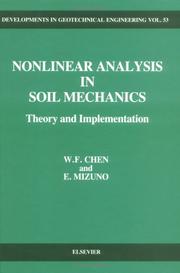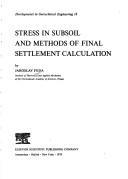| Listing 1 - 8 of 8 |
Sort by
|

ISBN: 0444430431 9780444430434 Year: 1990 Volume: 53 Publisher: Amsterdam : Elsevier,
Abstract | Keywords | Export | Availability | Bookmark
 Loading...
Loading...Choose an application
- Reference Manager
- EndNote
- RefWorks (Direct export to RefWorks)

ISBN: 0444998004 1299773966 0444596410 9780444998002 Year: 1978 Volume: 18 Publisher: Amsterdam, Netherlands : Elsevier Scientific Publishing Company,
Abstract | Keywords | Export | Availability | Bookmark
 Loading...
Loading...Choose an application
- Reference Manager
- EndNote
- RefWorks (Direct export to RefWorks)
Stress in Subsoil and Methods of Final Settlement Calculation
Soil mechanics --- Soil consolidation --- Mécanique des sols --- Mathematical models --- Modèles mathématiques --- Mathematical models. --- Mécanique des sols --- Modèles mathématiques --- Consolidation of soil --- Soils --- Foundations --- Settlement of structures --- Soil moisture --- Soil stabilization --- Consolidation --- Creep --- Soil mechanics - Mathematical models. --- Soil consolidation - Mathematical models.
Book
ISBN: 9400756747 9400756755 Year: 2013 Publisher: New York : Springer,
Abstract | Keywords | Export | Availability | Bookmark
 Loading...
Loading...Choose an application
- Reference Manager
- EndNote
- RefWorks (Direct export to RefWorks)
The recent earthquake disasters in Japan and a series of other disasters in the world have highlighted again the need for more reliable geotechnical prediction and better methods for geotechnical design and in particular dealing with geohazards. This book provides a timely review and summaries of the recent advances in theories, analyses and methods for geotechnical predictions and the most up-to-date practices in geotechnical engineering and particularly in dealing with geohazards. A special section on the geotechnical aspects of the recent Tohoku earthquake disaster in Japan is also presented in this book. Key Features: This book is written by a group of internationally renowned researchers and practioners to honour and mark the 40 years’ contribution of one of the greatest educators, researchers and engineers in the world, Professor Hideki Ohta, to geotechnical engineering. Professor Ohta is presently professor at Chou University after his retirement from Tokyo Institute of Technology, Japan. The book provides some first-hand information on the 2011 Tohuko earthquake disasters in Japan, the most recent update on the theories and methods for geotechnical analyses and predictions, and the latest methods and practices in geotechnical engineering, in particular, dealing with geotechnical hazard. It is a rare occasion for some 30 plus international authorities to write on their best topic that they have been working on for years. The book is a must-have collection for any libraries and professionals in geotechnical engineering.
Sedimentation and deposition -- Mathematical models -- Congresses. --- Soil mechanics -- Mathematical models -- Congresses. --- Civil & Environmental Engineering --- Engineering & Applied Sciences --- Civil Engineering --- Engineering geology. --- Natural disasters. --- Natural calamities --- Engineering --- Geology --- Earth sciences. --- Geotechnical engineering. --- Foundations. --- Hydraulics. --- Earth Sciences. --- Geotechnical Engineering & Applied Earth Sciences. --- Geoengineering, Foundations, Hydraulics. --- Natural Hazards. --- Geology. --- Disasters --- Civil engineering --- Geology, Economic --- Hydraulic engineering. --- Geognosy --- Geoscience --- Earth sciences --- Natural history --- Engineering, Hydraulic --- Fluid mechanics --- Hydraulics --- Shore protection --- Engineering—Geology. --- Flow of water --- Water --- Hydraulic engineering --- Jets --- Architecture --- Building --- Structural engineering --- Underground construction --- Caissons --- Earthwork --- Masonry --- Soil consolidation --- Soil mechanics --- Walls --- Engineering, Geotechnical --- Geotechnics --- Geotechnology --- Engineering geology --- Flow --- Distribution --- Details
Book
ISBN: 3642196292 9786613366672 3642196306 1283366673 9783642196294 Year: 2012 Publisher: New York: Springer,
Abstract | Keywords | Export | Availability | Bookmark
 Loading...
Loading...Choose an application
- Reference Manager
- EndNote
- RefWorks (Direct export to RefWorks)
Following the successful International Workshop on Modern Trends in Geomechanics held in Vienna in 2005, Stanford University hosted its sequel in 2010 under the theme Multiscale and Multiphysics Processes in Geomechanics. This book is a compilation of the extended abstracts from the Stanford workshop and highlights the diverse and complex processes encountered in geomechanics in terms of scale (from nanometer to kilometer) and scientific scope. Topics covered in this book include coupled physics phenomena such as thermo-poro-mechanical and electro-poro-mechanical processes, chemical species reactivity and transport, strain localization phenomena, unsaturated soils, fluid flow in porous solids, and dynamics of fault zones. The book also covers contributions dealing with the development of multiscale numerical techniques, as well as the laboratory and field investigation methods supporting these numerical techniques.
Geophysics -- Congresses. --- Multiscale modeling -- Congresses. --- Soil mechanics -- Mathematical models -- Congresses. --- Civil & Environmental Engineering --- Mechanical Engineering --- Engineering & Applied Sciences --- Civil Engineering --- Hydraulic Engineering --- Engineering geology --- Engineering. --- Geotechnical engineering. --- Geophysics. --- Engineering geology. --- Engineering --- Foundations. --- Hydraulics. --- Geoengineering, Foundations, Hydraulics. --- Geotechnical Engineering & Applied Earth Sciences. --- Geophysics and Environmental Physics. --- Geology. --- Hydraulic engineering. --- Engineering, Hydraulic --- Fluid mechanics --- Hydraulics --- Shore protection --- Engineering—Geology. --- Civil engineering --- Geology, Economic --- Geological physics --- Terrestrial physics --- Earth sciences --- Physics --- Engineering, Geotechnical --- Geotechnics --- Geotechnology --- Flow of water --- Water --- Hydraulic engineering --- Jets --- Architecture --- Building --- Structural engineering --- Underground construction --- Caissons --- Earthwork --- Masonry --- Soil consolidation --- Soil mechanics --- Walls --- Geology --- Flow --- Distribution --- Details

ISBN: 9061910412 9061910404 9061910420 9061910439 9061910447 9789061910404 Year: 1980 Publisher: Rotterdam: Balkema,
Abstract | Keywords | Export | Availability | Bookmark
 Loading...
Loading...Choose an application
- Reference Manager
- EndNote
- RefWorks (Direct export to RefWorks)
582.776 --- 581.9 <6> --- 581.522 --- Balsaminineae. Balsaminaceae. Balsams. Impatiens --- Geographic botany. Plant geography (phytogeography). Floras. Geographic distribution of plants--Afrika --- Individual ecology. Autecology --- Impatiens --- 581.522 Individual ecology. Autecology --- 581.9 <6> Geographic botany. Plant geography (phytogeography). Floras. Geographic distribution of plants--Afrika --- 582.776 Balsaminineae. Balsaminaceae. Balsams. Impatiens --- Numerical analysis --- Soil mechanics --- Soil engineering --- Soils --- Soils (Engineering) --- Geotechnical engineering --- Mechanics --- Foundations --- Soil physics --- Congresses --- Mathematical models&delete& --- Mathematical models --- Congresses. --- Soil mechanics - Mathematical models - Congresses. --- Numerical analysis - Congresses. --- Soil mechanics. --- Mathematical models. --- Numerical analysis. --- Mécanique des sols. --- Éléments finis, Méthode des. --- Analyse numérique.
Book
ISBN: 3642273947 3642428924 9786613575692 3642273955 1280397772 Year: 2012 Publisher: Berlin : Springer,
Abstract | Keywords | Export | Availability | Bookmark
 Loading...
Loading...Choose an application
- Reference Manager
- EndNote
- RefWorks (Direct export to RefWorks)
The purpose of this book is to bridge the gap between the traditional Geomechanics and Numerical Geotechnical Modelling with applications in science and practice. Geomechanics is rarely taught within the rigorous context of Continuum Mechanics and Thermodynamics, while when it comes to Numerical Modelling, commercially available finite elements or finite differences software utilize constitutive relationships within the rigorous framework. As a result, young scientists and engineers have to learn the challenging subject of constitutive modelling from a program manual and often end up with using unrealistic models which violate the Laws of Thermodynamics. The book is introductory, by no means does it claim any completeness and state of the art in such a dynamically developing field as numerical and constitutive modelling of soils. The author gives basic understanding of conventional continuum mechanics approaches to constitutive modelling, which can serve as a foundation for exploring more advanced theories. A considerable effort has been invested here into the clarity and brevity of the presentation. A special feature of this book is in exploring thermomechanical consistency of all presented constitutive models in a simple and systematic manner.
Continuum mechanics. --- Engineering. --- Hydraulic engineering. --- Materials. --- Soil mechanics -- Mathematical models. --- Soil mechanics. --- Surfaces (Physics). --- Mechanical Engineering --- Civil & Environmental Engineering --- Engineering & Applied Sciences --- Hydraulic Engineering --- Civil Engineering --- Engineering geology --- Soil mechanics --- Mathematical models. --- Engineering --- Geology --- Geotechnical engineering. --- Engineering geology. --- Foundations. --- Hydraulics. --- Structural materials. --- Materials science. --- Geoengineering, Foundations, Hydraulics. --- Continuum Mechanics and Mechanics of Materials. --- Geotechnical Engineering & Applied Earth Sciences. --- Characterization and Evaluation of Materials. --- Structural Materials. --- Geology. --- Civil engineering --- Geology, Economic --- Mechanics. --- Mechanics, Applied. --- Solid Mechanics. --- Classical mechanics --- Newtonian mechanics --- Physics --- Dynamics --- Quantum theory --- Engineering materials --- Industrial materials --- Engineering design --- Manufacturing processes --- Surface chemistry --- Surfaces (Technology) --- Applied mechanics --- Engineering, Mechanical --- Engineering mathematics --- Engineering, Hydraulic --- Fluid mechanics --- Hydraulics --- Shore protection --- Materials --- Engineering—Geology. --- Flow of water --- Water --- Hydraulic engineering --- Jets --- Architecture --- Building --- Structural engineering --- Underground construction --- Caissons --- Earthwork --- Masonry --- Soil consolidation --- Walls --- Material science --- Physical sciences --- Engineering, Geotechnical --- Geotechnics --- Geotechnology --- Architectural materials --- Building supplies --- Buildings --- Construction materials --- Structural materials --- Flow --- Distribution --- Details
Book
ISBN: 3642284620 3642433634 3642284639 Year: 2012 Publisher: Berlin ; New York : Springer,
Abstract | Keywords | Export | Availability | Bookmark
 Loading...
Loading...Choose an application
- Reference Manager
- EndNote
- RefWorks (Direct export to RefWorks)
The book analyzes a quasi-static fracture process in concrete and reinforced concrete by means of constitutive models formulated within continuum mechanics. A continuous and discontinuous modelling approach was used. Using a continuous approach, numerical analyses were performed using a finite element method and three different enhanced continuum models: isotropic elasto-plastic, isotropic damage and anisotropic smeared crack one. The models were equipped with a characteristic length of micro-structure by means of a non-local and a second-gradient theory. So they could properly describe the formation of localized zones with a certain thickness and spacing and a related deterministic size effect. Using a discontinuous FE approach, numerical results of cracks using a cohesive crack model and XFEM were presented which were also properly regularized. Finite element analyses were performed with concrete elements under monotonic uniaxial compression, uniaxial tension, bending and shear-extension. Concrete beams under cyclic loading were also simulated using a coupled elasto-plastic-damage approach. Numerical simulations were performed at macro- and meso-level of concrete. A stochastic and deterministic size effect was carefully investigated. In the case of reinforced concrete specimens, FE calculations were carried out with bars, slender and short beams, columns, corbels and tanks. Tensile and shear failure mechanisms were studied. Numerical results were compared with results from corresponding own and known in the scientific literature laboratory and full-scale tests. .
Soil mechanics -- Congresses. --- Soil mechanics -- Mathematical models -- Congresses. --- Soil mechanics. --- Concrete --- Finite element method --- Engineering & Applied Sciences --- Chemical & Materials Engineering --- Computer Science --- Materials Science --- Cracking --- Mathematical models --- Concrete construction --- Structural analysis (Engineering) --- Finite element method. --- Mathematical models. --- Engineering. --- Artificial intelligence. --- Computational intelligence. --- Computational Intelligence. --- Artificial Intelligence (incl. Robotics). --- Intelligence, Computational --- Artificial intelligence --- Soft computing --- AI (Artificial intelligence) --- Artificial thinking --- Electronic brains --- Intellectronics --- Intelligence, Artificial --- Intelligent machines --- Machine intelligence --- Thinking, Artificial --- Bionics --- Cognitive science --- Digital computer simulation --- Electronic data processing --- Logic machines --- Machine theory --- Self-organizing systems --- Simulation methods --- Fifth generation computers --- Neural computers --- Construction --- Industrial arts --- Technology --- FEA (Numerical analysis) --- FEM (Numerical analysis) --- Finite element analysis --- Numerical analysis --- Isogeometric analysis --- Building, Concrete --- Concrete building --- Construction, Concrete --- Building --- Artificial Intelligence.
Book
ISBN: 9048135303 9048135311 Year: 2010 Publisher: Dordrecht : Springer Netherlands : Imprint: Springer,
Abstract | Keywords | Export | Availability | Bookmark
 Loading...
Loading...Choose an application
- Reference Manager
- EndNote
- RefWorks (Direct export to RefWorks)
It is not an easy task to fascinate a student with a standard course on Soil Mechanics and Geotechnical Engineering. If, however, the same material is presented as a tool to explore a natural or a man-made "disaster", both the motivation and the ability to absorb this material increase dramatically. The case studies in this book could help to build an introductory Forensic Geotechnical Engineering course, covering such basic topics as settlements, bearing capacity and excavations. The failure cases considered in this book have something in common – they can be all reasonably well explained using so called "back-of-the-envelope" calculations, i.e., without sophisticated models requiring finite element analysis. These simple methods based on clear mechanical considerations are the endangered species of the computer dominated era, though sometimes they could prevent a disaster caused by a wrong application of computer models. In particular, the upper bound limit analysis has repeatedly proven itself as a powerful tool allowing for sufficiently accurate estimates of the failure loads and leaving a lot of room for creativity. No one is exempt from making mistakes, but repeating well known mistakes reveals a gap in education. One of the objectives of this book is to attempt bridging this gap, at least partially. More failure cases covering a larger area of geotechnical problems are included into the companion book "Geomechanics of Failures: Advanced Topics" by the same authors.
Electronic books. -- local. --- Soil mechanics -- Case studies. --- Soil mechanics -- Mathematical models. --- Structural failures -- Case studies. --- Structural failures -- Mathematical models. --- Structural failures --- Structural analysis (Engineering) --- Soil mechanics --- Mechanical Engineering --- Civil & Environmental Engineering --- Engineering & Applied Sciences --- Civil Engineering --- Hydraulic Engineering --- Investigation --- Mathematics --- Mathematical models. --- Collapse of structures --- Failures, Structural --- Soil engineering --- Soils --- Soils (Engineering) --- Mechanics --- Engineering. --- Earth sciences. --- Economic geology. --- Geotechnical engineering. --- Engineering geology. --- Engineering --- Foundations. --- Hydraulics. --- Geoengineering, Foundations, Hydraulics. --- Economic Geology. --- Geotechnical Engineering & Applied Earth Sciences. --- Earth Sciences, general. --- Geology. --- Deformations (Mechanics) --- Fracture mechanics --- Reliability (Engineering) --- Safety factor in engineering --- Structural stability --- Geotechnical engineering --- Foundations --- Soil physics --- Hydraulic engineering. --- Geology, economic. --- Geography. --- Cosmography --- Earth sciences --- World history --- Economic geology --- Physical geology --- Mines and mineral resources --- Engineering, Hydraulic --- Fluid mechanics --- Hydraulics --- Shore protection --- Mathematics. --- Engineering—Geology. --- Architecture --- Building --- Structural engineering --- Underground construction --- Caissons --- Earthwork --- Masonry --- Soil consolidation --- Walls --- Civil engineering --- Geology, Economic --- Geosciences --- Environmental sciences --- Physical sciences --- Engineering, Geotechnical --- Geotechnics --- Geotechnology --- Engineering geology --- Flow of water --- Water --- Hydraulic engineering --- Jets --- Details --- Geology --- Flow --- Distribution --- Geology, Economic.
| Listing 1 - 8 of 8 |
Sort by
|

 Search
Search Feedback
Feedback About UniCat
About UniCat  Help
Help News
News